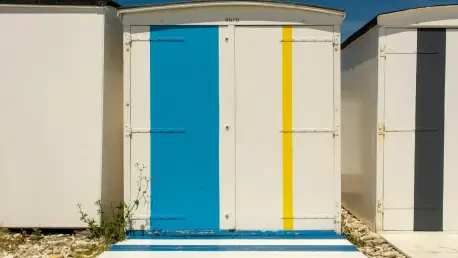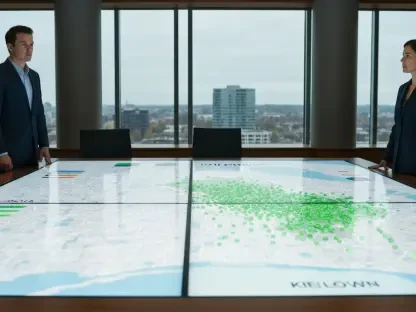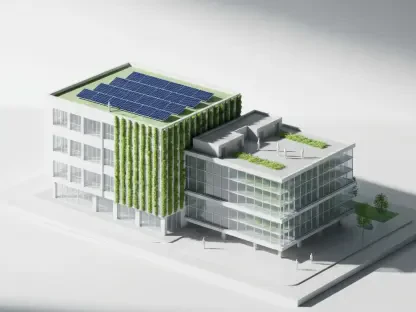Stepping into contemporary times, the landscape of coastal cottage architecture has dramatically evolved, painting a vibrant tapestry where tradition meets innovation. These seaside abodes, popularized for their romantic simplicity and idyllic charm, have embraced modern aesthetics, merging historical influences with sleek, innovative designs. As one looks to the shorelines today, coastal cottages reflect a notable shift towards eclectic, personalized styles that depart from the standard motifs of yesteryears. This metamorphosis has not only enriched the visual language of coastal homes but has also introduced an intrinsic harmony with their natural environments.
Fusion of Architectural Styles
The Rise of Diverse Architectural Influences
Today’s coastal cottages exemplify a rich fusion of architectural influences, where strict adherence to tradition gives way to a tapestry of cultural styles. The melting pot of design draws inspiration from across the globe, incorporating elements ranging from European manorial elegance to the rustic charm of Spanish haciendas. This eclectic approach is a definitive step away from standard coastal motifs, allowing homeowners to manifest their character and heritage into their living spaces. Rather than conforming to a single design philosophy, these cottages embrace Southern charm, seamlessly weaving it with contemporary minimalist principles, thus offering a broader spectrum of styles.
Such diversity is more than just an aesthetic choice; it resonates with a cultural movement towards individuality and authenticity in living spaces. By melding various architectural narratives, coastal cottages today become canvases that tell unique stories, reflecting personal journeys and cultural interconnections. These inspirations not only influence the exteriors but are mirrored in interior designs that continue the narrative. Whether drawing from the iconic mansard roofs of French architecture or the expansive patios of Mediterranean homes, today’s coastal cottages present a celebration of design diversity, all while staying true to their seaside roots.
Crafting Uniqueness with Contrasting Materials
The allure of modern coastal cottages lies in their innovative use of contrasting materials to create textured facades bursting with character. Gone are the singular exteriors characterized by uniform finishes; what emerges now is an artful blend of materials, each contributing its own unique beauty. Cedar shingles interlock with creamy brickwork, while terracotta pavers meet contemporary metal roofing, crafting exteriors that resonate with both rugged robustness and understated elegance. This thoughtful selection of diverse materials not only adds depth but also serves as an invitation to explore the symbiotic relationships within the structure.
Warmth and character, signature traits of inviting homes, are accentuated through elements like aged wood and modern metallic accents, which together form a visual dialogue on tradition and innovation. These material choices have far-reaching implications, extending beyond aesthetics into the realms of environmental consciousness by embracing sustainable practices. Incorporating locally sourced and eco-friendly materials, coastal cottages not only enhance their immediate surroundings but also commit to a broader ecological responsibility. This conscientious design ethos signifies a deeper understanding of the impact architecture has on the environment, creating homes that are as responsible as they are visually captivating.
Color and Character
Breaking Away from Traditional Palettes
In recent years, coastal cottages have boldly transcended the conventions of color palettes traditionally perceived as soft and subdued. Today’s designs are distinguished by an adventurous use of color, departing from synonymous soft blues for more vibrant, lively hues that make bold statements. The embrace of striking colors like punchy reds or bright yellows serves not only as a testament to the dynamic nature of modern design but also as an invitation to homeowners to express their individuality. Accent features decorated in these lively shades transform homes into personalized retreats, displaying a contemporary take on the classic coastal dwelling aesthetic.
It’s a departure that emphasizes the importance of individuality in home design, offering a canvas upon which to overlay one’s distinct personality and stylistic preferences. This trend encourages risk-taking and creativity, pushing the boundaries of conventional color applications to craft spaces that are both vibrant and charming. Furthermore, the use of color here is tactically calculated; vibrant hues are placed to highlight architectural features, drawing the eye to intricate detailing and crafted structures. This evolution of color usage vividly showcases the shift towards personalization in architecture, reinforcing the message that homes are living embodiments of their inhabitants’ creativity and taste.
Emphasizing Porch Characteristics
Beyond color experimentation, the architectural gravitas of modern coastal cottages often rests on their extensive and inviting porches, symbolizing the heart of seaside living. These porch designs capture the essence of a laid-back coastal lifestyle, providing a serene sanctuary for relaxation and outdoor enjoyment. Synonymous with hospitality, these porches welcome guests with their Southern charm, featuring haint blue ceilings or sophisticated pergola-lined decks that extend the living space into nature. This integration not only typifies the coastal spirit but also actively embraces the surrounding landscape, offering a seamless transition between interior comfort and exterior beauty.
Today, porches stand as architectural testaments to the importance of outdoor living, inviting not only calm and relaxation but also enlivening the social aspect of these homes. In the design, one can observe a keen focus on connecting the inside with the outside, utilizing open layouts and transparent barriers such as large window panels to blur the line between the interior and the great outdoors. This worldwide embrace of biophilic design principles reflects a growing appreciation for nature and the benefits of natural light and fresh air, creating healthy, rejuvenating spaces for residents and guests alike. As more people seek to escape the hustle and bustle of urban environments, these porches present more than an architectural feature—they offer a lifestyle choice centered around tranquility and hospitality.
Integration with Nature
Landscaping in Coastal Aesthetics
The integration of stunning landscapes with architectural designs emerges as a cornerstone of coastal cottage aesthetics, emphasizing a symbiotic coexistence with nature. Homeowners and designers alike prioritize landscapes that not only complement the home but also enhance the natural surroundings, crafting aesthetic harmony with their environments. This approach sees cottages surrounded by native flora that requires low maintenance while boosting regional biodiversity. Through this, aesthetic architecture finds its match in thoughtful landscaping that respects and revitalizes natural habitats.
Notably, the strategic infusion of plant life throughout the property—ranging from native grasses to vibrant blooms like bougainvillea—ties aesthetics to the ecological role, enabling a natural extension of the home’s design ethos into the garden. These choices mitigate environmental impacts while offering visual appeal, spotlighting how sustainability and style can coalesce. This growing trend aligns with the global movement towards sustainable living, where designs are evolving beyond structures to encompass entire ecosystems. Coastal cottages now embody environmental stewardship, respecting the delicate shoreline balance and proving that good design can indeed nurture the natural world.
Sustainability and Responsible Material Use
The modern narrative of coastal cottages has embraced sustainability as a key element, underpinned by a commitment to environmentally responsible design. An emphasis on sustainably sourced materials not only elevates the aesthetic quality of these homes but ensures they tread lightly on their surroundings. Whether employing reclaimed wood, recycled metal, or regionally sourced stone, the choices reflect a dedication to minimizing ecological footprints while crafting picturesque vistas. In the face of changing climate conditions, this approach signifies architectural resilience, ensuring structures not only coexist with nature but actively contribute to its preservation.
This sustainable ethos extends to every component, from the choice of energy-efficient windows to the use of solar energy integrated subtly into the design. Rather than an afterthought, sustainability is interwoven seamlessly into the architecture, proving that beauty and environmental responsibility can exist hand-in-hand. As the conversation around climate change grows more urgent, the coastal cottage serves as a beacon of harmonious design. It offers an inspiring model for how dedication to sustainability can enhance life quality, reduce the carbon footprint, and ensure these idyllic homes inspire wonder and awe for generations to come.
Innovating Traditions
Bright and Open Spaces for Coastal Living
Today’s beachfront dwellings are characterized by spaciousness and light, embracing architectural designs that favor openness and connectivity. Such attributes are not only aesthetically pleasing but also functionally significant, altering the conventional understanding of space within cottages. The prevalence of expansive windows and open floor plans allows for an unobstructed flow of natural light, resulting in interiors that are vibrant, airy, and deeply intertwined with their natural surroundings. This design strategy capitalizes on the stunning coastal views and the relentless play of sunlight and shadow, creating spaces that evoke serenity and rejuvenation.
In doing so, such homes cater to the modern proclivity for harmony between indoor and outdoor spaces, where the boundaries become sublime transitions rather than harsh borders. The prominence of glass as a material reflects a design choice that prioritizes openness, providing visual continuity with the landscape while maintaining energy efficiency. These architectural nuances cater to the desire for homes that not only exemplify beauty but function as seamless extensions of the natural world, allowing residents to enjoy the full spectrum of coastal living year-round.
Balancing Tradition with Modern Innovation
The enduring appeal of coastal cottages lies in their ability to gracefully blend tradition with advanced innovation, resulting in homes that honor past influences while embracing contemporary ideas. This harmonious integration manifests in architectural details, where classic gabled roofs meet sleek, modern finishes like large steel-framed windows. Such combinations offer both aesthetic appeal and practical advantages, optimizing the structures for durability and style. A defining aspect of this approach is the adaptive reuse of traditional elements, drawing from historical architectural vocabularies to create spaces that are both familiar and refreshingly modern.
This balance is also reflected in material selection, as seen in the pairing of aged stone features with avant-garde color schemes, bridging the temporal gap between historical charm and contemporary innovation. These elements symbolize ingenuity and resourcefulness, highlighting the capacity of designers to innovate without losing sight of cultural roots. As architects endeavor to shape future coastal cottages, the prevailing narrative emphasizes melding craftsmanship with cutting-edge technology—ensuring homes are not only appealing but robust in the face of coastal elements. This seamless fusion of past and present positions coastal cottages as timeless icons, continually evolving to meet modern demands while preserving their iconic appeal.
Future Horizons
In recent times, the architecture of coastal cottages has seen a significant transformation. These charming seaside homes, once celebrated for their romantic simplicity and idyllic appeal, now reflect a dynamic fusion of tradition and modern innovation. The iconic coastal cottage has shed its uniform past, embracing contemporary design elements while maintaining a nod to its historical roots. This blend of old and new results in a refreshing aesthetic that speaks to the uniqueness and individuality of each home, inviting personalized touches that distinguish them from the once-standard designs of previous eras.
Today, as you stroll along the shorelines, you’ll notice how these homes have evolved both visually and functionally. The fusion of eclectic styles with modern sensibilities has led to a rich architectural diversity that enhances the natural beauty of their surroundings. This evolution is not just about aesthetics; it reflects a deeper understanding and appreciation of the coastal environment. Architects are now integrating sustainable materials and eco-friendly designs, ensuring these homes not only look harmonious with their settings but also interact positively with the natural ecosystems around them. This modern approach has helped coastal cottages remain relevant and cherished, embodying a lifestyle that celebrates both the past and the future.









